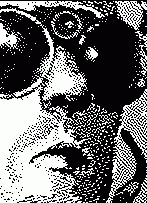 Set in the cyber city, our hero Shatter is a sometimes-hired private eye. He has a bad attitude and needs one with the freaks he has to deal with. He is always looking for an edge to dance on and often finds one.
Set in the cyber city, our hero Shatter is a sometimes-hired private eye. He has a bad attitude and needs one with the freaks he has to deal with. He is always looking for an edge to dance on and often finds one.(two views)
"Shatter" will always holds a soft spot in my heart. It was the first comic done on a Macintosh. Now, this was wayyyy back in the bitty box days of 1985. Using a mouse (like drawing with a block of soap), a 9-inch monitor (so you're never bothered by how the whole page looks), and MacPaint 1.0 (which didn't even let you see the whole screen of the 9" monitor!), Mike Saenz created art, and showed the world this kind of thing COULD be done. He even performed this impressive feat while young, foolish, and poor. He had to run an extension cord from a hallway power outlet, as the power company had curtailed service to Mr. Saenz's apartment for bills in arrears.

Saenz went on to create such digital delights as "MacPlaymate," "Virtual Valerie" and, most recently, "SpaceShip Warlock," the first interactive CD-Rom Science Fiction Adventure.
(P. Sugarman)
In a typically seedy, corporate controlled, cyberpunk future, the world's largest media corporation has found a source of cheap talent: stealing other people's RNA. One person can inject another's RNA and gain that person's abilities. However, the effect is temporary. Temporary, that is, except for one person: Shatter. Shatter is a temp-cop who everyone wants. You see, if you can shoot up with Shatter's RNA, then you get his talent of absorbing and "retaining" talent.
Billed as "the first computer generated comic," this book was done around 1985. Remember 1985? MacDraw and MacPaint were still being refined. Laserwriters had just come out. Shit, there were hardly any fonts to choose from back then. So, yeah, "Shatter" looks pretty rough. The whole thing was done with MacPaint and MacDraw. Maybe it's not fair to judge it by today's standards, but the majority of the work is crude and ugly... and I remember thinking that at the time the book first came out. Saenz seemed to have been caught up in the cleverness of a "computer comic," thinking that fact would excuse any weaknesses in the book as a whole.
Actually the art is not entirely computer generated. The coloring was done by hand. Mediocre coloring, that is. It looks rushed - big, washy and ugly. But there are a few panels that are nicely executed and the covers are pretty eye-catching.
I've always enjoyed Saenz's shorter comic stories, i.e., the stuff he did in the old "Epic Illustrated" anthology magazine. I've also enjoyed his illustrations and album covers. But he seems to have gotten lost with Shatter. It's about 150 pages long and the story just sort of jumps all over the place. All we get is a bunch of pale Blade Runner rip-offs. From the Phillip Marlowe-type overdub, to a blonde Darryl Hannah lookalike, retro-fitted buildings, semi-retarded electricians, etc, etc. Nothing is rationalized, especially the most important question: "Why does this media mega-corp want to steal RNA to create talented people?" Better TV scripts? Better TV commercials? It's never really explained.
This story is something only the initiated cyberpunk should bother reading. Someone unfamiliar with the medium would have trouble filling in the holes. As for the artwork, it's worth owning only as a curiosity. If you want great Michael Saenz art and stories, check out the pages of "Epic Illustrated."
You can pick up the four individual issues of "Shatter" for around $2 each There is a collected graphic novel which is on sale most places for $3.50.
(J. Bergin)
Links:
![]()
ACCESS:
Shatter
Mike Saenz & Peter Gillis
First Comics
(out of print)
Limited copies are currently available from Bud Plant for $3.50.
![]()
